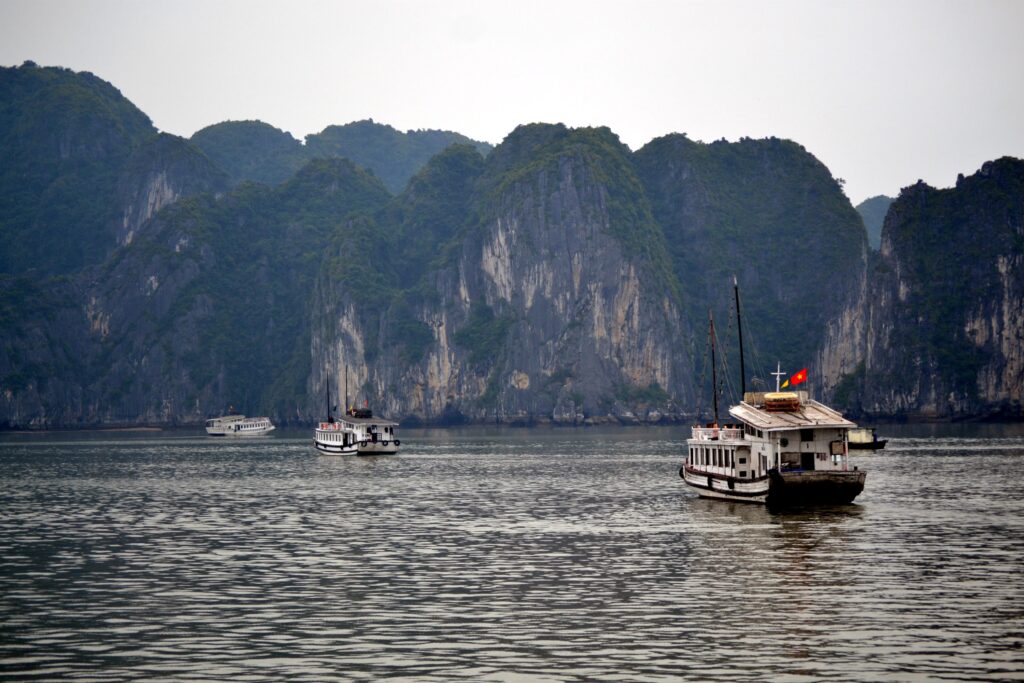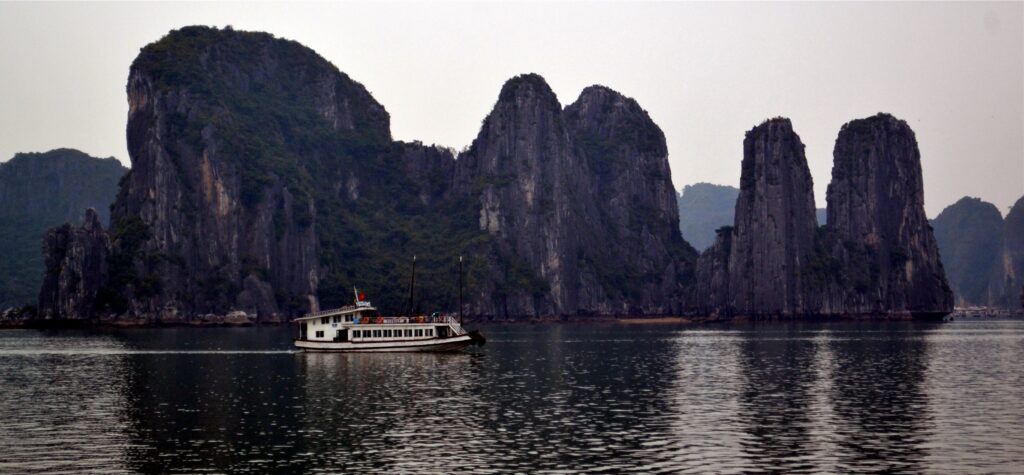Text and Photos by Henrylito D. Tacio
We had only three days in Hanoi, the capital city of Vietnam. On our first two days, we toured the historical places of the city. On our third day, we went to Halong Bay, which I first saw in the Discovery Channel when I was still in the United States.
Wikipedia describes it this way: “Hạlong Bay is a mature karst landscape developed during a warm, wet, tropical climate. The sequence of stages in the evolution of a karst landscape over a period of 20 million years requires a combination of several distinct elements including a massive thickness of limestone, a hot wet climate and slow overall tectonic uplift.”
Although we left Sofitel Metropole Hotel early in the morning, we arrived at the seaport by 11:30. We did have two stopovers: the first one, where we had our snack, and the second time was at the place where pearls were cultured.
Immediately after parking, all of us trooped to the building where our journey to Halong Bay would start. Our tour guide, Hung Nguyen, bought the tickets for us. And when we left the building, we were completely mesmerized.

Boats cruising the Halong Bay 
Some of the islands of Halong Bay
The protruding mountains were too gorgeous to look at — although they were still far where we were standing. It was a little bit cloudy — sort of a haze — and cooler (after all, it was still wintertime).
“It is either we go ahead climbing the Dong Thien Cung cave first or we eat our lunch,” Hung asked the group. However, he suggested doing the former before the latter so we won’t be heavy (courtesy of the meal) in scaling the 100-step stairs going up.
That was what we did. As soon as we boarded the deluxe boat that would bring us to one of the islands of Halong Bay, all of us could only wonder. Most of them were already taking pictures as we approached one of the islands when I broke the silence: “Excuse me, excuse me.” And everyone allowed me to pass without any howls of protest.
I went straight to the upper portion of the boat, and everyone followed me after that. We had fun taking photos of the several islands before us. “This is worth our trip,” said Ruben Gonzaga, Pinoy Big Brother winner who was with us.
After hitting the island’s shoreline where the Dong Thien Cung was located, we stepped at the cemented stairs and proceeded immediately to the ticket booth. Then, we took the steps going up. When we reached the 50th steps, we stopped and had our souvenir picture taken.

Getting inside
We took the remaining 50 steps and went inside the cave. I was totally captivated by what I saw inside. Colored lights were used to make the different forms of stalagmites truly enthralling.
“When the French left the country, they never told us that this cave existed,” Nguyen said. “It was a fisherman who discovered this place. He was trying to find a place where he could keep himself dry from the rain. He saw a small hole and went inside. And the rest was history.”
After conquering the cave, we went back to our boat. Feeling so hungry already, we had a sumptuous lunch. We had steamed rice and the usual Vietnamese tea. But the viands were superb: steamed shrimp with ginger, fried fish with tomato sauce, fried squid with butter, steamed clams with lemongrass, seafood spring roll, stir-fried chicken with onion and mushroom and pumpkin soup with shrimp.
After eating, we went to the rooftop of the boat and took more photos. There are about 1,969 islands, according to our guide. Curiously enough, that was the year too when the country’s first president, Ho Chi Minh, died.
A selfie here and a selfie there — which is what was what most of us were doing. After an hour or so, all of us stood still. We were silent. The air was cooler (but we were wearing jackets anyway), and the sun was nowhere to be found. There was sort of fog all over the bay, but we can still marvel at God’s creation.

Ha, Long Bay is located in the Gulf of Tonkin, within Quang Ninh Province, in the northeast of Vietnam. Covering an area of 43,400 hectares and including over 1,600 islands and islets, most of which are uninhabited and unaffected by humans, forms a spectacular seascape of limestone pillars. It is an ideal model of a mature karst landscape developed during a warm and wet tropical climate. The property’s exceptional scenic beauty is complemented by its great biological interest.
Before the 19th century, the name Halong Bay had not been recorded in Vietnam’s old books. It has been called An Bang, Luc Thuy, and Van Don. It was not in the late 19th century that the name Halong Bay appeared on the Maritime map of France.
Haiphong News, published in French, reported: “Dragon appears on Halong Bay.” According to the story, a certain Lieutenant Lagoredin captain of Avalangso met a couple of giant sea snakes on Halong Bay three times in 1898. Not only the lieutenant but also many other sailors saw those species. The European thought that those animals looked like Asian dragons. That appearance of strange animals led to the name of the Quang Ninh sea area today: Halong Bay.
Even before we have visited Ha Long Bay, several Vietnamese writers have hailed it. “This wonder is ground raising up into the middle of the high sky,” wrote Nguyễn Trãi. Nguyên Ngọc penned: “…to form this first- rate wonder, nature only uses: stone and water…There are just only two materials themselves chosen from as much as materials, in order to write, to draw, to sculpture, to create everything…It is quite possible that here is the image of the future world.”
“It is a wonder that one cannot impart to others,” Ho Chi Minh rhapsodizes. Lord Trịnh Cương, overflowed with emotion, said: “Mountains are glistened by water shadow, water spills all over the sky.”
In 2000, UNESCO added Halong Bay to its World Heritage List, according to its outstanding examples representing major stages of the Earth’s history and its original limestone karstic geomorphologic features.
“Comprised of a multitude of limestone islands and islets rising from the sea, in a variety of sizes and shapes and presenting picturesque, unspoiled nature, Halong Bay is a spectacular seascape sculpted by nature,” UNESCO said. “The property retains a high level of naturalness, and despite its long history of human use, is not seriously degraded. Outstanding features of the property include the magnificent towering limestone pillars and associated notches, arches and caves, which are exceptionally well-developed and among the best presented of their type in the world.”

